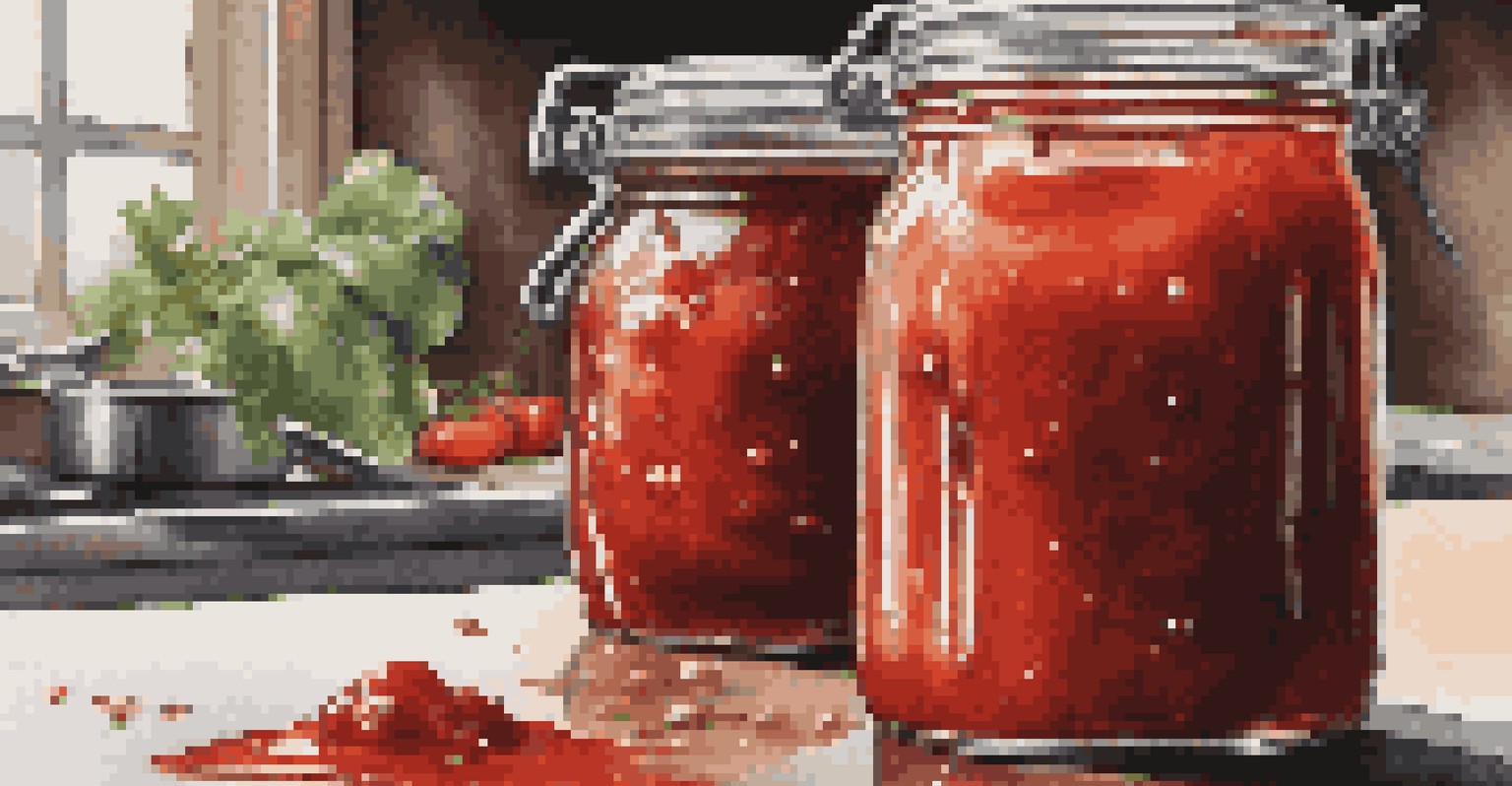Making Hot Sauce: A Guide to Fermented and Canned Varieties

Understanding the Basics of Hot Sauce Making
Hot sauce is more than just a condiment; it's a flavorful experience. At its core, hot sauce is made from chili peppers, vinegar, and various spices. Understanding the basic components can help you create a sauce that suits your taste buds perfectly.
Hot sauce is like life. You have to find the right balance of sweet and spicy to truly enjoy it.
The beauty of hot sauce lies in its versatility. From smoky chipotle to tangy vinegar-based sauces, the options are endless. You can experiment with different pepper varieties and additional ingredients to find your unique flavor profile.
By grasping the fundamentals, you pave the way for more advanced techniques, like fermentation, which can elevate your sauce's complexity and depth. So, let’s dive deeper into the art of making hot sauce!
Exploring Fermented Hot Sauce Techniques
Fermentation is a magical process that transforms simple ingredients into something extraordinary. When you ferment your hot sauce, the natural bacteria on the peppers break down sugars, resulting in a tangy, complex flavor that fresh sauces can't replicate.

To start, you'll need fresh chili peppers, salt, and water. Simply combine these ingredients in a jar and let them sit for a few weeks, allowing the flavors to meld and develop. Don’t forget to check on them regularly; the bubbling action is a good sign of fermentation!
Basics of Hot Sauce Making
Hot sauce combines chili peppers, vinegar, and spices, allowing for endless flavor experimentation.
Once fermented to your liking, blend the mixture with vinegar for added brightness and preserve it in bottles. This method not only enhances flavor but also adds probiotics, making your sauce a tasty gut-friendly option.
Canning Your Hot Sauce for Long-Term Storage
Canning is a fantastic way to preserve your hot sauce and enjoy it year-round. The process involves heating the sauce to eliminate bacteria and sealing it in jars to create a vacuum. This method ensures your sauce remains fresh and flavorful for months.
Cooking is like love; it should be entered into with abandon or not at all.
Before you start canning, make sure to sterilize your jars and lids. This step is crucial to prevent spoilage. Once your hot sauce is ready, fill the jars, leaving some headspace, and process them in a boiling water bath for the recommended time.
After canning, allow the jars to cool and check for proper seals. A successfully sealed jar will create a popping sound as it cools, indicating it's ready for storage. Now you can enjoy your homemade hot sauce any time!
Choosing the Right Peppers for Your Hot Sauce
The choice of peppers is fundamental to your hot sauce's flavor and heat level. From the mild bell pepper to fiery habaneros, each variety brings a unique taste and spiciness. Consider what flavor profile you want to achieve when selecting your peppers.
If you prefer a milder sauce, opt for jalapeños or Anaheim peppers. For those who crave heat, ghost peppers or Carolina reapers can provide the kick you're looking for. Don’t hesitate to mix and match different peppers for a well-rounded flavor.
Importance of Fermentation
Fermentation enhances flavor complexity and adds probiotics, transforming your hot sauce into a gut-friendly option.
Experimenting with different peppers can be a fun journey. Keep a taste journal of your combinations to help you refine your recipes and discover what works best for your palate.
Balancing Flavor: Salt, Sugar, and Acidity in Hot Sauce
Creating a well-balanced hot sauce involves understanding the roles of salt, sugar, and acidity. Salt not only enhances flavor but also acts as a preservative during fermentation. It's essential to find the right amount to complement your peppers without overpowering them.
Sugar can be used to balance out the heat, providing a touch of sweetness. Honey, agave, or even fruits can add interesting layers to your sauce. A little experiment—adding pineapple or mango can create a delightful sweet-spicy blend.
Lastly, acidity from vinegar or citrus juice brightens your sauce and adds freshness. A balanced combination of these elements will elevate your hot sauce, making it not just spicy, but a complex flavor experience.
Creative Additions: Herbs, Spices, and Other Ingredients
While peppers are the star of the show, other ingredients can take your hot sauce to the next level. Fresh herbs like cilantro or basil can add an aromatic touch, while spices such as cumin or smoked paprika can introduce depth and warmth.
Consider adding garlic or onion for an earthy flavor, or even fruit for a unique twist. The beauty of hot sauce making is that you can personalize it to your liking, so don’t be afraid to get creative!
Storing and Using Hot Sauce
Proper storage is essential for maintaining freshness, and homemade hot sauce can elevate various dishes.
Remember, start with small amounts when introducing new ingredients. This way, you can control the flavor balance and ensure your hot sauce remains delicious and cohesive.
Storing and Using Your Homemade Hot Sauce
Once you’ve crafted your hot sauce masterpiece, proper storage is key to maintaining its freshness. Store your sauce in a cool, dark place, or in the fridge if it contains fresh ingredients. A well-sealed bottle can keep your sauce flavorful for months.
When it comes to using your hot sauce, the possibilities are endless! Drizzle it on tacos, mix it into marinades, or even add it to soups for an extra kick. You’ll find that homemade hot sauce can enhance a variety of dishes.

Don’t forget to share your creations with friends and family. Homemade hot sauce makes for a thoughtful gift, and who doesn’t love a little heat in their life?